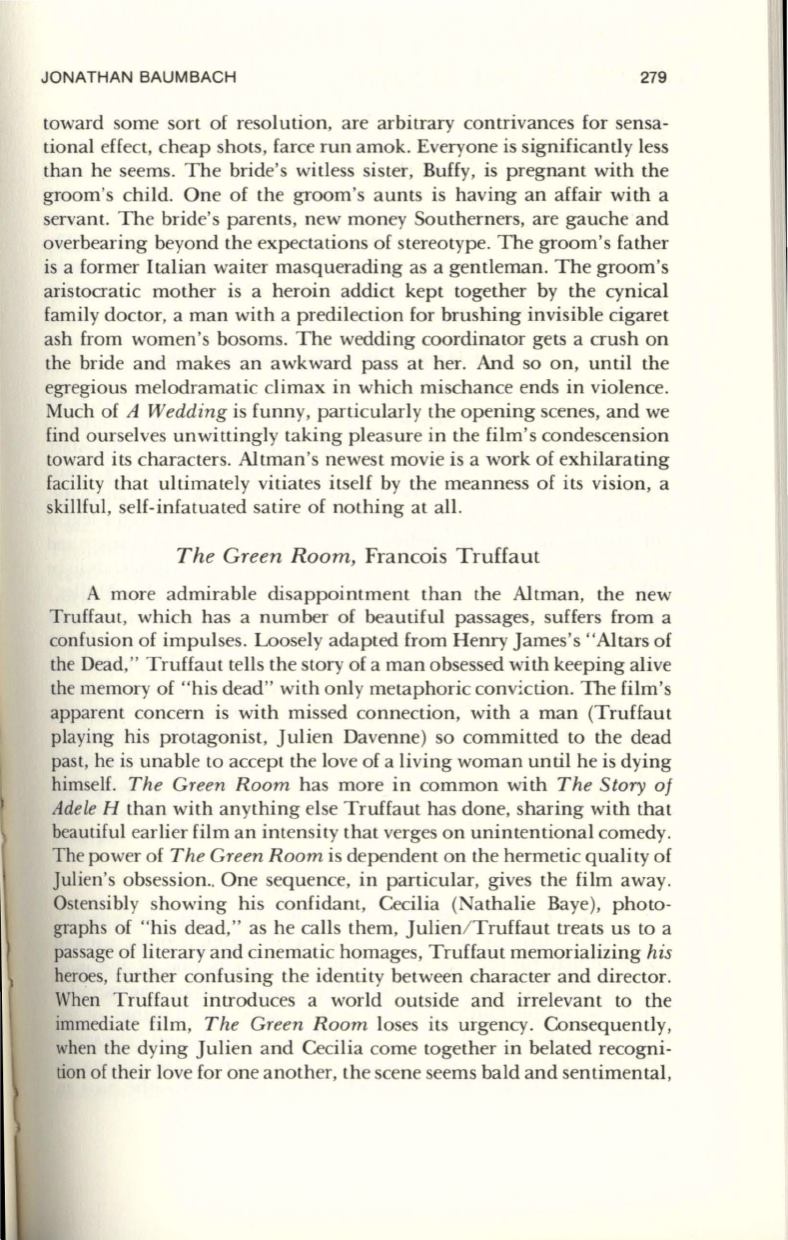
JONATHAN BAUMBACH
279
toward some sort of resolution, are arbitrary contrivances for sensa–
tional effect, cheap shots, farce run amok. Everyone is significantly less
than he seems. The bride's witless sister, Buffy, is pregnant with the
groom's child. One of the groom's aunts is having an affair with a
servant. The bride's parents, new money Southerners, are gauche and
overbearing beyond the expectations of stereotype. The groom's father
is a former Italian waiter masquerading as a gentleman. The groom's
aristocratic mother is a heroin addict kept together by the cynical
family doctor, a man with a predilection for brushing invisible cigaret
ash from women 's bosoms. The wedding coordinator gets a crush on
the bride and makes an awkward pass at her. And so on, until the
egregious melodramatic climax in which mischance ends in violence.
Much of
A
Wedding
is funny, particularly the opening scenes, and we
find ourselves unwittingly taking pleasure in the film's condescension
toward its characters. Altman's newest movie is a work of exhilarating
facility that ultimately vitiates itself by the meanness of its vision, a
skillful, self-infatuated satire of nothing at all.
The Green Room,
Francois Truffaut
A more admirable disappointment than the Altman, the new
Truffaut, which has a number of beautiful passages, suffers from a
confusion of impulses. Loosely adapted from Henry James's "Altars of
the Dead," Truffaut tells the story of a man obsessed with keeping alive
the memory of "his dead" with only metaphoric conviction. The film's
apparent concern is with missed connection, with a man (Truffaut
playing his protagonist, Julien Davenne) so committed to the dead
past, he is unable to accept the love of a living woman until he is dying
himself.
The Green Room
has more in common with
The Story of
Adele
H than with anything else Truffaut has done, sharing with that
beautiful earlier film an intensity that verges on unintentional comedy.
The power of
The Green Room
is dependent on the hermetic quality of
julien's obsession.. One sequence, in particular, gives the film away.
Ostensibly showing his confidant, Cecilia (Nathalie Baye), photo–
graphs of "his dead," as he calls them, Julien/ Truffaut treats us to a
passage of literary and cinematic homages, Truffaut memorializing
his
heroes, further confusing the identity between character and director.
When Truffaut introduces a world outside and irrelevant to the
immediate film,
The Green Room
loses its urgency. Consequently,
when the dying Julien and Cecilia come together in belated recogni–
tion of their love for one another, the scene seems bald and sentimental,


